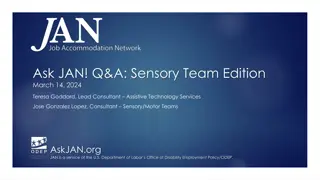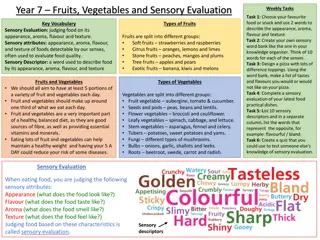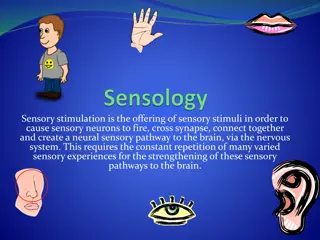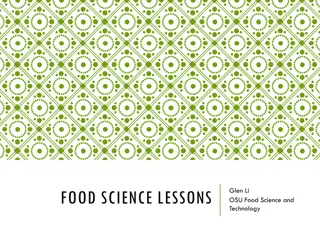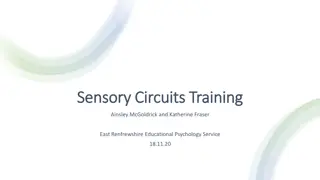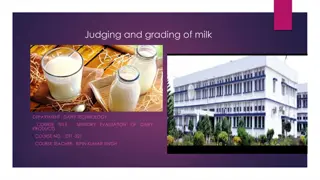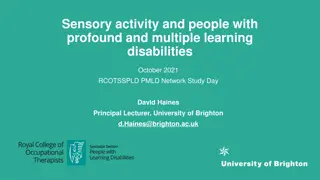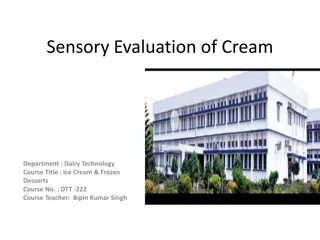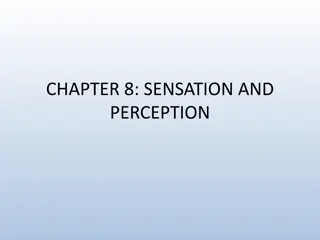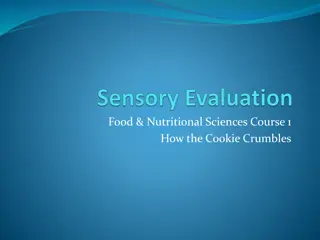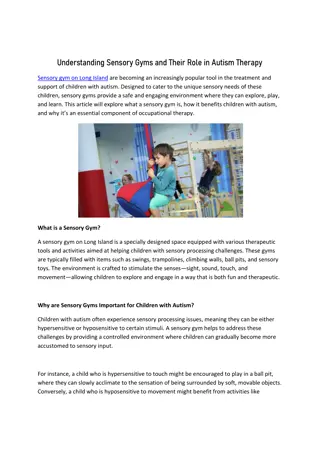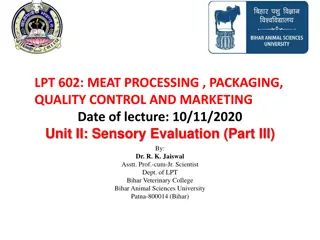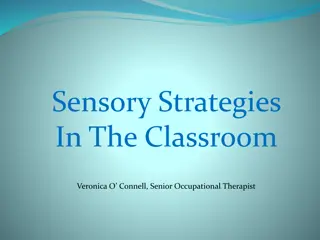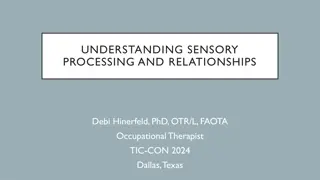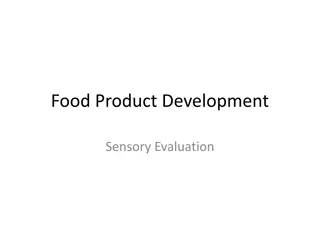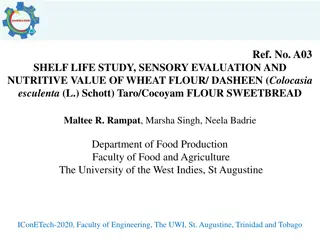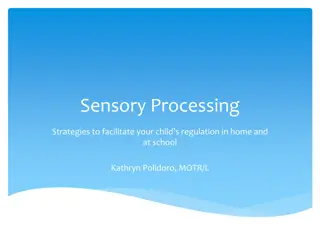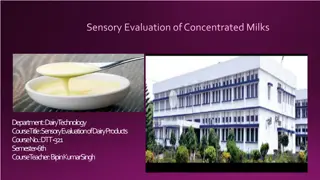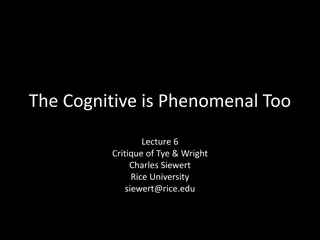Understanding Sensory Evaluation in Food Science
Sensory evaluation in food science involves analyzing human responses to the characteristics of food and beverages using the senses of sight, smell, taste, touch, and hearing. This scientific discipline aims to elicit, measure, analyze, and interpret reactions to the sensory attributes of food products. The human senses, including taste, play a crucial role in this process, with taste buds on the tongue responsible for detecting five primary tastes: sweet, salt, sour, bitter, and umami. The tongue's taste buds, located in various types of papillae, are essential taste receptors that contribute to the sensory evaluation of food products.
Download Presentation

Please find below an Image/Link to download the presentation.
The content on the website is provided AS IS for your information and personal use only. It may not be sold, licensed, or shared on other websites without obtaining consent from the author. Download presentation by click this link. If you encounter any issues during the download, it is possible that the publisher has removed the file from their server.
E N D
Presentation Transcript
SENSORY EVALUATION .. BASICS OF SENSORY EVALUATION, TOOLS, TECHNIQUES, METHODS B.K.SINGH, DAIRY TECHNOLOGY
SENSORY EVALUATION Sensory evaluation is a scientific discipline that analyses and measures human responses to the composition and nature of foods and drink. Sensory evaluation does not just deal with "likes and dislikes, OK or not OK but the process scientifically elicits, measures, analyses and interprets psychological and / or physiological responses to physical stimuli produced by a food product.
SENSORY EVALUATION DEFINITION: A scientific discipline used to evoke, measure, analyze and interpret reactions to those characteristics of food and materials as they are perceived by senses of sight, smell, taste, touch and hearing. INSTITITE OF FOOD TECHNOLOGISTS; USA
HUMAN SENSES Sense may be described as the physiological perception of a stimuli. There are 5 senses in human beings: Sight : Ability of the eye and brain to detect electromagnetic waves within the visible range of light and interpret the image. Hearing : Sense of sound. When vibrations propagating through a medium (e.g. air) are detected by the brain, sound is perceived. Touch : Sense of pressure perception, mostly in the skin / tongue. Taste Smell
HUMAN SENSES TASTE / GUSTATION: This is a "chemical" sense. The receptors (buds) in the tongue can distinguish 5 tastes: Sweet Salt Sour Bitter Umami : a savoury and subtle taste that is associated with a soupy or brothy note. The receptors on the tongue identify the glutamic acid residues in the food.
TASTE SYSTEM The tongue is the main taste receptor. The structures that give the tongue its rough structure with raised protrusions on the surface are called papillae. Four types of papillae present in the human tongue: Fungiform papillae Fili form papillae Foliate papillae Circumvallate papillae Taste buds are located in all the papillae except for the Filiform papillae. Tongue contains approximately 10,000 taste buds.
TASTE SYSTEM TONGUE SURFACE WITH PAPILLAE Each taste bud has taste cells that extend into the taste pore. Every taste cell is associated with one or more nerve fibres. when chemicals from food contact the tips of taste cells, Ion movement across the membrane of taste cells takes place to cause transduction. These signals reach the spinal cord through many pathways and then go to the Thalamus. The brain detects the taste of the food.
TASTE Taste is expressed in terms of a food being sweet rich metallic weak cool bitter umami tart zesty acidic warm strong hot citrus tangy sour mild savoury sharp spicy salty bland rancid
SMELL / ODOUR The nose detects volatile aromas released from food. A specific odour may be described for a particular food, e.g. green, cheesy, nutty etc. The intensity can also be recorded. Odour and taste of a food together produce the flavour of a food. Due to this mechanism, people suffering from cold find it difficult to determine the flavours in foods. Usually odours are described as aromatic leathery mossy fragrant pungent spicy woody floral bland green citrus like earthy rancid savoury rotten tart oily creamy acrid strong mild buttery musty weak scented
SCIENCE OF SMELL : OLFACTION We humans are microsmatic : we do not possess a keen sense of smell as it is not crucial for our survival. Humans can discriminate among 100,000 odors but they cannot label them accurately. First, odor molecules from food bind to receptors in the nose. Signals from the receptors travel up to the olfactory bulb, a Qtip-like structure roughly above the eyes. From there, some signals go to the primary olfactory cortex and on to the higher-order parts of the brain. But few signals from the olfactory bulb directly go to the amygdala in the brain, an area that is relevant to emotions and some go to the hippocampus, which is involved in memory. Hence, we sometimes associate few smells in our memory with a specific emotion.
SCIENCE OF SMELL : OLFACTION THE OLFACTORY SYSTEM Recognition immediate as the olfactory response is extending directly to the brain. of smell is immediate, This is the only place where our central nervous system is directly exposed environment to the
SENSORY PROCESS As all food products have a range of attributes and dimensions, the parameters usually studied in sensory evaluation are Visual: package appearance, product appearance, color, shape size etc. Appearance plays an important part in helping to determine our first reaction to a food. Tactile / Touch: Product feel, temperature, texture, softness etc. Texture is assessed through touch and physical contact with food. The resistance to chewing also affects texture, e.g. crunchy, chewiness. Gustatory: Product taste. When food is placed in the mouth, the surface of the tongue and other sensitive skin reacts to the feel of the surface of the food and creates a mouth-feel of the food.
SENSORY PROCESS The mouth also senses the temperature of the food, which plays an important stimulus, e.g. cold ice cream, warm toast, hot soup etc. Olfactory: product Aroma and Flavour. Auditory: sound when consumed crisp, crunchy etc. There are various methods to conduct sensory analysis of foods. Based on the test method, samples are prepared and panel members are chosen. The SENSORY PROCESS IS COMPLEX AND INVOLVES THE PERCEPTION OF ALL THE SENSES WHEN FOOD IS CONSUMED.
SENSORY EVALUATION : NEED To detect the similarities /differences in a group of food products. To evaluate an existing food product against benchmark sample. To analyze food samples for further improvements based on market feed back. To elicit specific response to a food sample: whether acceptable or not by consumers. To study a particular property in an ingredient or a food product. To evaluate if a ready food product meets its original specification / standard sample. To obtain feedback data in order to make decisions and carry out suitable modification in a food product.
SENSORY EVALUATION : USES New Product development Before a new product promotion Determine the effect of formulation changes especially when availability of natural ingredients is scarce. Study the impact of processing changes. Ensure batch consistency. Monitor shelf-life changes. Determine consumer acceptance Expert versus consumer sensory report Sensory quality control and consumer loyalty Sensory evaluation in Food Science courses
SENSORY EVALUATION : PLAN Define the overall project objective Define the test objective. Screening the samples. Selection of the test method and panel. Conducting the test. Analyzing the data Reporting the results. Corrective action , if required.
SENSORY EVALUATION : REQUIREMENT Sophisticated Sensory booths as per ASTM standards with controlled temperature (20C 22 C) and RH at 40 5%. Suitable Lighting in booths : White or Masked. Utensils / glass wares suitable for different foods. Laboratory for physical, chemical analysis of raw and prepared foods. Suitable area for preparation of food samples for evaluation. Suitable coding of samples : usually 3 digit coding is done. Appropriate method of sample presentation. Sensory panel members suitable for evaluation. Specialized software for statistical evaluation of sensory data.
SENSORY METHODS Product oriented analytical & objective Quality / quantity of a trait Likeness / difference in samples For Standardization purposes Few selected trained panel members DESCRIMINATIVE DESCRIPTIVE o People oriented affective & subjective Acceptance of a product Initial impressions important Personal reactions / likes matter Usually more panel members eg. Samples tasted by people visiting a booth in a crowded mall. 20 HEDONIC PREFERENCE
SELECTION OF PANEL MEMBERS American Society for Testing and Materials, Committee E-18 has given the guidelines for selection & training of sensory panel members. The selection of candidates should be based on specific personal attributes and potential capability in performing specific sensory tasks. Must be able to perform and repeat the task with consistent results. Panel members must be free from taste / odor perception disorders, color blindness, denture defects, frequent allergies not be consuming medications that affect sensory functions.
SENSORY PANEL MEMBERS Panel motivation, responsible sensory evaluation. members must have and interest attitude towards Panel members may be trained or randomly selected based on the type of evaluation required.
SENSORY METHODS Discriminatory tests Simple Difference - which sample is different? Triangle test Duo-trio test Directional Difference - which sample is sweeter? Paired comparison test Preference tests : Ranking test Scoring or Scaling - how PUNGENT is the sample? Sensitivity tests
DISCRIMINATORY TESTS Discriminatory tests are done to determine whether the two samples are perceptibly different. When 2 samples are chemically different and may be perceived as identical. When there is a change in the processing method of a food product. Discriminatory tests are extremely useful for evaluation of a new, improved version of an already existing product.
HEDONIC TEST Very useful for measuring food acceptability. Uses a 9- point Hedonic scale ranging from extremely dislike to extremely like . It is a people oriented test with large number of panel members, usually 50 and above. An extension of Hedonic scale with nine child friendly expressions ranging from super good to super bad is used with 5-10 year old children. A scale having smiley faces also elicits good response for food acceptability from children.
HEDONIC SCALE The 9-Point Hedonic Scale Point Like Extremely 9 Like Very Much 8 Like Moderately 7 Like Slightly 6 Neither Like nor Dislike 5 Dislike Slightly 4 Dislike Moderately 3 Dislike Very Much 2 Dislike Extremely 1
TRIANGLE TEST Panelist is presented with one different and two alike samples. If possible, all three samples should be presented to the panelist at once, and the panelist should be instructed to taste the samples from left to right. The six possible order combinations should be randomized across panelists. For samples A and B, the six possible order combinations are: AAB, ABA, BAA, BBA, BAB, and ABB. The panelist is instructed to identify the odd sample and record his answer
TRIANGLE TEST You are given three coded PRODUCT samples out of which two are identical and one is different. Please encircle the code of the sample found different. oIndicate the degree of difference between the dentical and different samples: Very less ---------- Significant ---------- Much ---------- Very high ---------- Please tick the acceptable sample: Identical samples --------- Different sample --------- Remarks, if any: Thank you. Name: --------------- Date ------------
DUO TRIO TEST A Reference is provided with 2 coded samples. Is useful for products that have relatively intense taste, odor, and/or kinesthetic effects. A Duo-Trio Test determines whether or not a sensory difference exists between two samples. The degree / intensity of difference is not elicited . This method is particularly useful: To determine whether product differences result from a change in ingredients, processing, packaging, or storage To determine whether an overall difference exists, where no specific attributes can be identified as having been affected.
DUO TRIO TEST You are given one Control sample of PRODUCT labelled as R . Along with that there are two coded test samples out of which one is identical with R and the other is different. Tick the sample found different. Sample code 619 _____ 352 _____ Comments: Name: Date:
PAIRED COMPARISON TEST The paired-comparison test (UNI EN ISO 5495) determines whether two products differ in a specified attribute, such as sweetness, crispness, redness, etc. Two differently coded samples are presented to each panelist simultaneously . (30 & more members) The panelist chooses the one that is perceived as more intense in the specified sensory attribute. The paired comparison implicates the forced choice and therefore the judges must give an answer in any case. The chance probability associated with this test is 1/2. Frequently used in Preference tests.
PAIRED COMPARISON TEST Start with the coded sample on your left. Tick the sample that is more Better than others. AB --------- BA --------- Comments: Name: Date:


